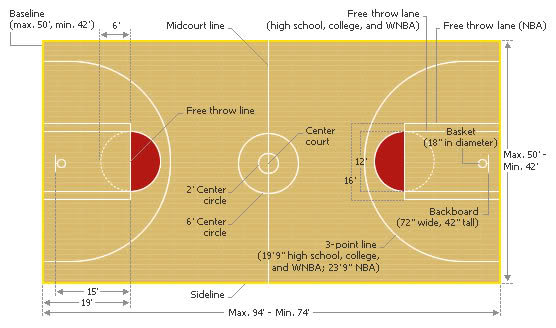Basic Steps
Let me preface this “how to†session by stating a quickly forgotten fact: basketball is a team sport, and is supposed to be fun!
But, it is a competitive sport, with its share of contact, and most people hate to lose. In all, it is addictive and has become a favorite sport, both recreationally and professionally, in America and abroad.
It is played either indoors or outdoors on a 94ft long by 50ft wide court (regulation size) of hardwood (indoor), or blacktop (outdoor). At the two opposite ends of the court are
netted, often metal, hoops 18†in diameter mounted on square backboards, suspended fr-om posts. The top of each rim should be at a regulation height of 10ft above the floor (See figure below).

*Note that the common free throw line, or foul line, is 15 ft. fr-om the front of the rim.
*The Key—or the rectangle extending outward fr-om
| under the rim, with the multicolored circle on top—is also called the “paint†and is prime real estate during game play. |
Game Objective
A basketball player’s primary objective is to help his team throw the ball through the opposing team’s hoop as many times as possible, while stopping opponents fr-om accomplishing the same,
within an allotted period of time, usually 4 fifteen minute quarters, ten minute increments in college and high school.
Player Positions
Point Guard—primary ball carrier, agile, good passer, and runs the offense.
#2 Guard (shooting guard)—possesses the same abilities as point guard but is usually a better shooter.
Small Forward—agile, able to defend under the rim, powerful scorer.
Strong or Power Forward—is usually the grunt worker in the paint, great defender/rebounder, but can score when necessary.
Center—is usually the tallest player on the floor, aggressive defender in the paint and ardent shot blocker. He/she is usually the anchor of the offense.
Playing the Game (full court)
First, the referee tosses the ball up in the air at center court.
Second, one selected representative fr-om each team tries to out-maneuver the other to tap the ball to one of their teammates.
Third, the team that catches the ball plays offense and begins passing the ball (slang, “rockâ€) to each *other, moving the ball down the court, while the opposing team plays *defense and tries to take the ball away, hoping to prevent them fr-om scoring.
*Should they succeed, the roles immediately reverse, and the ball is pushed back the other way.
*Each team has five players on the court at a time: a point guard (primary ball handler), a #2 (shooting) guard, a small forward, a power forward and a center.
Fourth, as a ball handler—any position—either *dribbles the ball to the hoop or takes a shot fr-om anywhere on the floor, the defender cannot make illegal body contact or a *foul will be called. If the shooter makes the shot despite the illegal contact, he is awarded one foul shot fr-om the free throw line (totaling 3 or 4 points depending on whether the shot was taken fr-om inside/outside the 3-point line; if his shot does not go in, he is awarded two/three free throws, again depending on where the shot was taken fr-om. All free throws are taken uncontested and un-timed.
*Ball handler must not carry the ball—traveling violation—and, once the dribble is discontinued, the ball carrier must pass or shoot and cannot dribble again unless his opponent dislodges the ball.
*For a complete list of fouls go to: Complete List Of Basketball Rule terms!
Fifth, the team that scores the most points in the allotted period of time wins! If the score is tie at the end of “regulationâ€, then a five minute overtime period is played. This continues until either team finishes with the most points.
Further Reading and Additional Resources
Wikipedia Article on Basketball
More Detailed Article on ‘How to play Basketball’ w/ history, rules, etc.